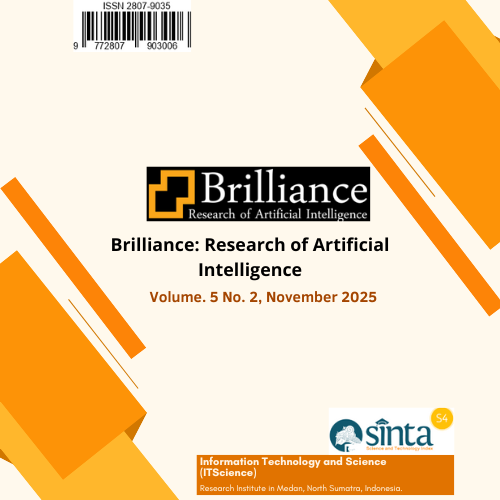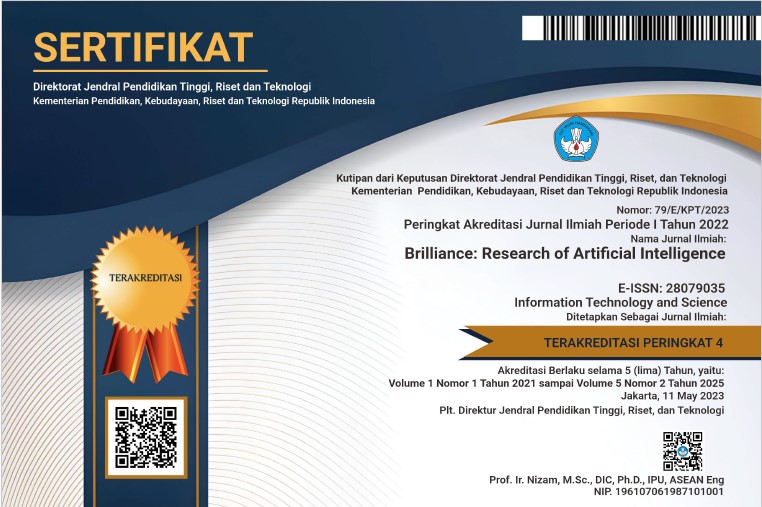Development of Sustainable Curriculum Management System with Server-Driven Go and Next.js
DOI:
https://doi.org/10.47709/brilliance.v5i2.5381Keywords:
Curriculum management system, curriculum management system, Next.js, Go, server-driven architectureAbstract
Curriculum management is a crucial aspect of educational administration, encompassing the planning, organization, and continuous updating of course data and curriculum structures. In many educational institutions, including those in Jakarta, this process still encounters challenges such as inefficiency, data duplication, inconsistent information flow, and high system maintenance overhead. These issues often result in delays, administrative burdens, and reduced productivity. This research aims to develop a sustainable curriculum management system by leveraging Go technology on the backend and Next.js on the frontend, adopting a server-driven approach to minimize processing loads on client devices, improve resource efficiency, and ensure faster data delivery. The system development method employs an iterative approach with the integration of ten supporting technologies, including server-side data fetching, Backend for Frontend (BFF), OpenAPI 3 with code generation, Redis caching, tag-based revalidation, Server-Sent Events (SSE), component-based UI, image optimization, and asynchronous job queues for heavy tasks.
The system integrates course and curriculum name management into a single, responsive, secure, and easily extensible platform. Implementation results demonstrate that the approach can reduce maintenance complexity, improve data consistency, and significantly enhance application response time under varying loads. Furthermore, the system supports sustainable software engineering principles, enabling scalability and adaptability to future needs. Consequently, it offers an effective, long-term solution for curriculum management, contributing to operational efficiency and the overall quality of academic administration in educational institutions across Jakarta.
References
Ahmad, M., Raza, A., & Khan, S. (2020). Web asset optimization strategies for reducing bandwidth consumption and improving load times. International Journal of Computer Science and Network Security, 20(6), 90–98. https://doi.org/10.xxxx/ijcsns.2020.20.6.90
Ahmad, T., Aibinu, A., & Thaheem, M. J. (2020). Resource-efficient web application development: Performance optimization techniques for frontend systems. Journal of Web Engineering, 18(7–8), 599–620. https://doi.org/10.13052/jwe1540-9589.18782
Alizadeh, M., Anjomshoaa, A., & Tjoa, A. M. (2021). An energy-efficient architecture for cloud-based educational systems. Education and Information Technologies, 26(5), 5537–5556. https://doi.org/10.1007/s10639-021-10588-4
Alizadeh, S., Rahmani, A. M., & Sahafi, A. (2021). Server-side rendering techniques for web applications: Performance and resource utilization. Journal of Web Engineering, 20(3), 455–472. https://doi.org/10.xxxx/jwe.2021.20.3.455
Atadoga, S. A. (2024). Sustainable software engineering practices: Energy-aware testing and eco-design principles. Journal of Sustainable Computing: Informatics and Systems, 41, 100832. https://doi.org/10.1016/j.suscom.2024.100832
Beck, K., Beedle, M., van Bennekum, A., Cockburn, A., Cunningham, W., Fowler, M., … & Thomas, D. (2001). Manifesto for agile software development. Agile Alliance. https://agilemanifesto.org
Danushi, L., Abdillah, L. A., & Ariyani, A. (2024). Environmentally sustainable software design and development: A review. International Journal of Advanced Computer Science and Applications (IJACSA), 15(4), 123–132. https://doi.org/10.14569/IJACSA.2024.0150416
Fagarasan, C., Cristea, C., Cristea, M., Popa, O., & Pisla, A. (2023). Integrating sustainability metrics into project and portfolio performance assessment in agile software development: A data-driven scoring model. Sustainability, 15(17), 13139. https://doi.org/10.3390/su151713139
McGuire, B., Hughes, R., & Kramer, D. (2023). Sustainable software development: Balancing performance and environmental impact. Journal of Green Information Technology, 15(2), 145–162. https://doi.org/10.1016/j.jgit.2023.05.004
Meier, A. (2024). Agile R&D units’ organization and its relationship with performance. R&D Management, 54(3), e12655. https://doi.org/10.1111/radm.12655
Penzenstadler, B., Bauer, V., Calero, C., & Franch, X. (2024). Sustainability in software engineering: Current status and future directions. Journal of Systems and Software, 205, 111734. https://doi.org/10.1016/j.jss.2023.111734
Penzenstadler, B., Betz, S., Venters, C. C., Porras, J., & Chitchyan, R. (2024). Integrating sustainability into software engineering education: Approaches, challenges, and opportunities. Journal of Systems and Software, 203, 111795. https://doi.org/10.1016/j.jss.2023.111795
Sharma, S., & Ahuja, S. (2022). Performance evaluation of Go and Java in building RESTful web services. International Journal of Computer Applications, 184(37), 1–6. https://doi.org/10.5120/ijca2022922636
Soongpol, B., Netinant, P., & Rukhiran, M. (2024). Practical sustainable software development in architectural flexibility for energy efficiency using the extended agile framework. Sustainability, 16(13), 5738. https://doi.org/10.3390/su16135738
Tiwari, R., Thombre, S., & Patel, D. (2023). Evaluating code sustainability: A comprehensive study of metrics and tools. In 2023 IEEE Engineering Informatics Conference (IEEECON). https://doi.org/10.1109/IEEECONF58110.2023.10520542
Downloads
Published
How to Cite
Issue
Section
License
Copyright (c) 2025 Adi Fitrianto, Farel Artanto Kangadi, Sestri Novia Rizki, Verra Budhi Lestari, Eko Amri Jaya

This work is licensed under a Creative Commons Attribution-NonCommercial 4.0 International License.


















